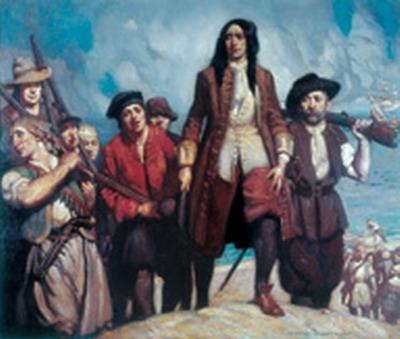|
|
|||
|
|
|
|
|
|
|
|||
WILLIAM DAMPIER1651 - 1715
|
|
|
|
|
William Dampier (son of George and Ann Dampier) was born in 1651 at East Corker, Somerset, England. Some books quote 1652 but this was a cousin - also named
William - who was born to George's brother William Sr.
|
|
It was at this stage that he first seems to have come into contact with the privateers that operated in the area although he did not yet join up with them.
While at One Bush Key, he lost most of his possessions during a storm (1676) before working his passage back to England in 1678.
|
|
|
|
|
|
On January 15th 1688 the ship sailed into the waters of the north west coast of Australia. (January 5th is sometimes quoted but this was based on the old
Julian calendar not the Georgian calendar that later came into use in Europe.) Dampier is often quoted as the first Englishman to set foot on the
Australian mainland but there is no proof that he was the first member of the crew of the Cygnet to step ashore. The ship's new Captain, named Reed or
Read, barely gets a mention in the history books.
|
|
|
In 1698 Dampier received a commission from the British Admiralty and one might have expected that he would be given a sound sea-worthy vessel with which to
sail to the other side of the world and conduct his exploration. Sadly for Dampier the HMS Roebuck was a worm ridden rotting hulk fit only for the breakers
yard. Perhaps the Admiralty's intense dislike of Buccaneers led them to send him off in a vessel they hoped would sink under him (which in fact it
eventually did).
|
|
|
First landfall was made on August 1st 1699 somewhere along the coast south of Shark Bay (named Shark's Bay by Dampier). No fresh water could be found so the
ship sailed north along the coast. (What a difference there might have been in the voyage if Dampier had sailed south instead!)
|
|
|
|
|
|
Chronology
1651 - Born possibly in September but the exact date is unknown. 1673 - Joined the Royal Navy. 1679 - Joined the crew of buccaneer, Captain Bartholomew Sharp. 1683 - Joined with privateer John Cooke. 1686 - Transferred to the Cygnet. 1688 - Anchored off the northwest coast of Australia on January 5th near King Sound. 1691 - Returned to England. 1697 - Published the book 'A New Voyage Round the World'. 1699 - Given command of HMS Roebuck. 1699 - Set out for Australia on January 14th. 1699 - Arrived at Shark Bay on August 6th. 1701 - HMS Roebuck run-aground and is unrepairable at Ascension Island on February 21st. 1701 - Returned to England in August after being picked up by a passing ship. 1702 - Royal Navy court martial on June 8th. 1703 - Published the book 'A Voyage to New Holland'. 1703 - Sailed from Ireland in company with the ship Cinque Ports. 1703 - Became commander of the St George. 1704 - Arrived off Chile in February. 1704 - Engaged in a battle with the better armed Spanish galleon, Nuestra Señora del Rosario and had to withdraw. 1707 - Returned to England after being imprisoned by the Dutch. 1708 - Served aboard the Duke as sailing master. 1709 - Captured the Spanish galleon, Nuestra Señora de la Encarnación y Desengano in December. 1710 - Serving as sailing master aboard the Encarnación. 1711 - Returned to England on October 14th. 1715 - Died - exact date not known.
Links to more information:
|
|
|
Become a supporter of this website for just $5 a month
|





